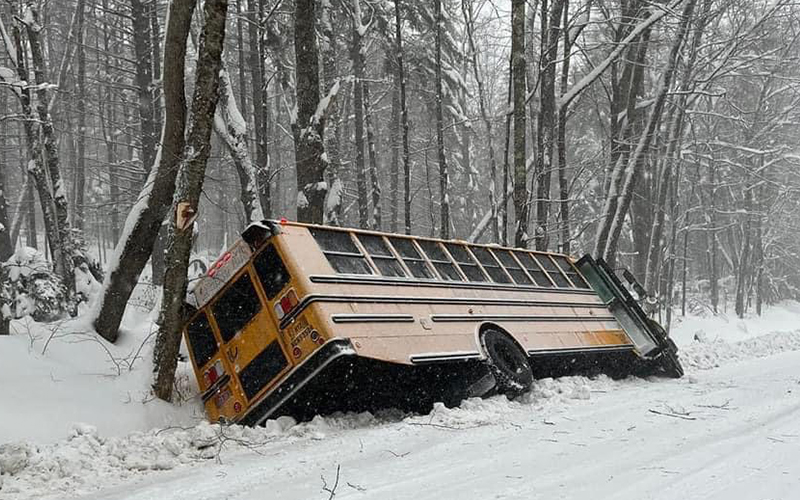Schools in the Harwood Unified Union School District were closed last Monday, January 23, after road crews advised the central office and the bus barn that snow was falling too fast for road crews to stay ahead for the morning bus routes. Then the snow stopped sooner than expected. Fast forward to Thursday, January 26, when the weather forecast suggested bands of snow thoughout the day – which turned out to be an understatement and led to a difficult afternoon bus run that left three buses off the road.
HUUSD Superintendent Mike Leichliter met with The Valley Reporter and Waterbury Roundabout on Friday afternoon, January 27, to talk about the school district protocol for busing incidences such as these but also the science and art of balancing the need to keep kids home during inclement weather with the need to get them to school.
All students, drivers, staff and the public were uninjured on Thursday when three buses slid off the road. Administrators from Fayston Elementary School, Warren Elementary School and Brookside Primary School were able to get on scene and get kids transferred to alternate buses.
Leichliter said a Fayston Elementary School bus slid off the road and into a ditch near Kew-Vasseur Road. A Brookside bus slid off the road on Route 100 between Crossett Brook and Harwood Union. Other car accidents closed that road requiring that students get transferred to another bus and then transported to Harwood via Route 2 and Route 100B. Finally a bus with one student slid off the road in Warren.
Leichliter said he was up early on Thursday morning and went out to check local roads where he found a lot of unplowed roads. He checked in with Dan Sargent at First Student who told him all the road crews had checked in and said they’d be ready for an on-time start to the school day.
“Their concern was that if we delayed and we would actually be in the midst of a second wave that started the rain bands that were predicted,” he said.
That afternoon around 1:30 or 2 o’clock he noticed that the snow flurries had turned into steady snow, which then turned into a lot of snow.
“At that point it takes about two hours to get an early dismissal going. There wasn’t enough time to do that so we just have to proceed through,” he explained.
Leichliter said that there were some takeaways from the day. The first of which is that there needs to be a command center where he can be based with radio contact with drivers and other administrators. The fact that drivers were connected to the bus barn by radios, with some bus barn employees driving buses in and out of cellphone service made things more complicated.
He said the command center might look like him going to the bus barn where you can have radio contact with drivers.
“So I just need to centralize that process. Hopefully, we won't have to use it this year. But we do need to have a process in place of how we handle the phone calls and the communications and the checking in on drivers and the estimated time of bus arrivals, because of the issues with cellphones, right,” he said.
He explained that the school buses have instant chains that the drivers can deploy as needed. All of the buses that slid off the road last week we’re equipped with chains; however, the Warren bus chains malfunctioned.
Another take away for the superintendent will be to cultivate more and varied weather prediction sources, he said.












